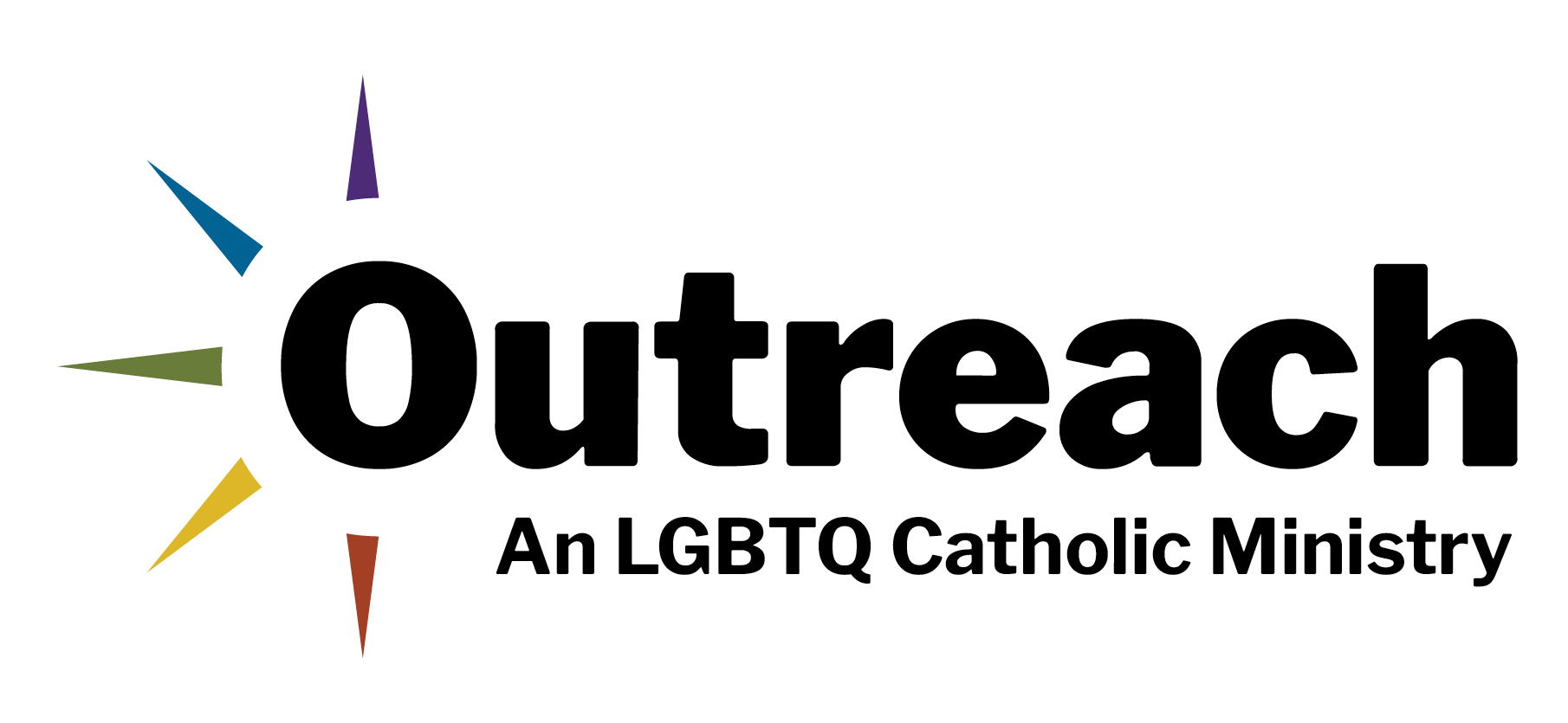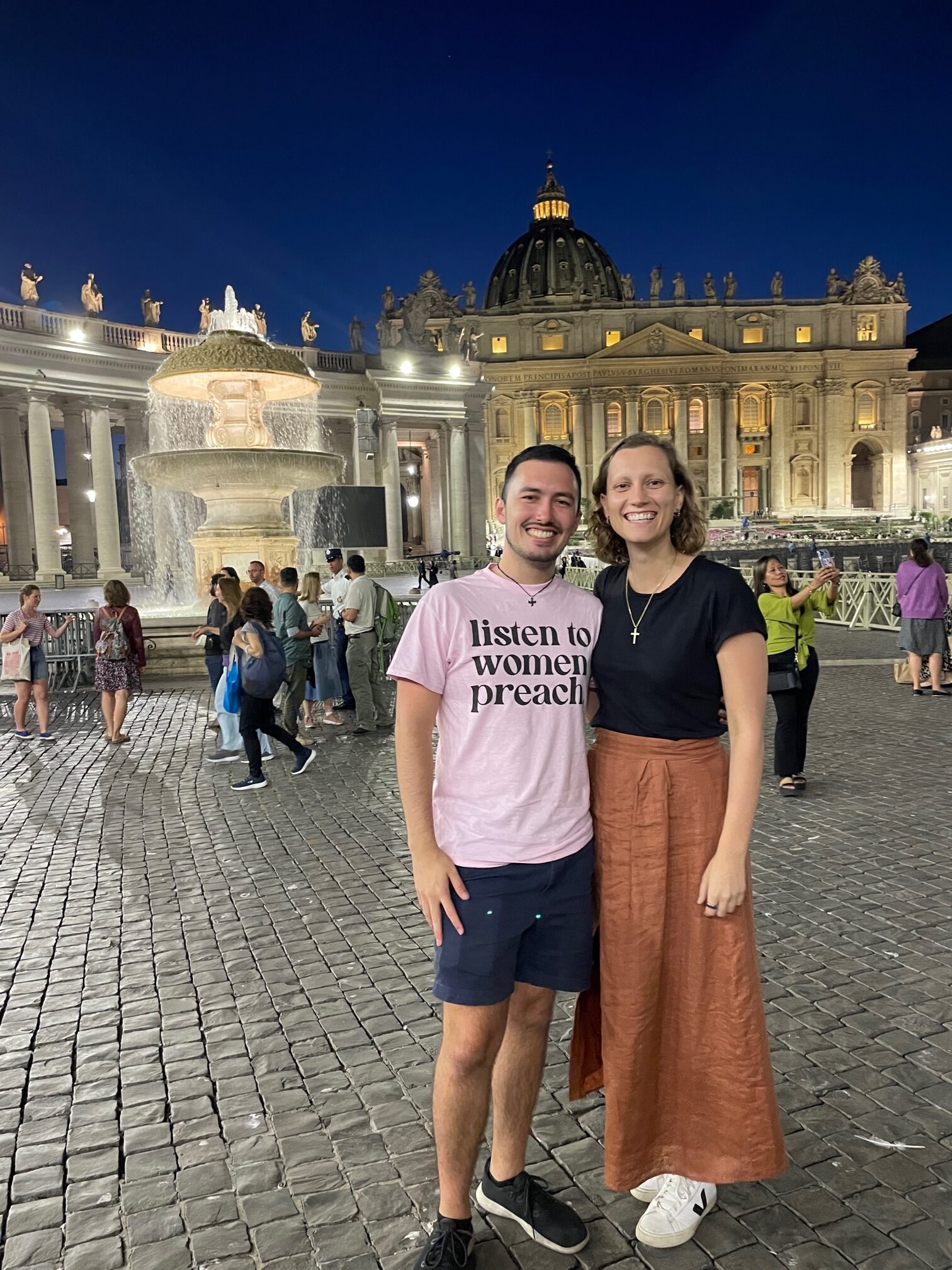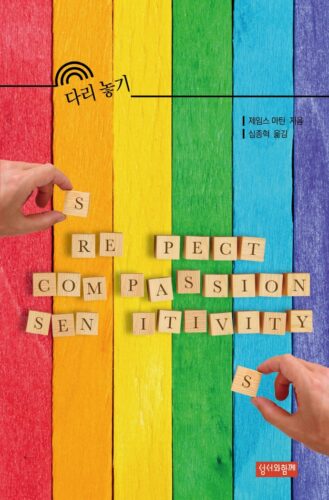When I told people that my friend Grace and I were traveling to the Vatican ahead of the Synod for the opening ecumenical prayer vigil, on September 30, I was often met with puzzled looks. I didn’t blame them. An ordained Presbyterian woman minister and a queer Catholic man en route to see the pope felt more like the opening to a homily punchline than the makings of a pilgrimage.
But rooted in our respective traditions, a Huguenot-descendant Protestant and an Irish Catholic, we made our way to Rome, excited to bear witness to a church on the precipice of change.
Our journey began months earlier, at a friend’s wedding that Grace officiated. At the reception, I told Grace about the Synod and how I felt compelled as a queer Catholic to witness such an important inflection point in the church’s history. Grace jumped at the idea. She had heard of the Synod as a Reformed chaplain at Georgetown, and had felt inspired by the pope’s call for young Christians of all denominations to gather together at St. Peter’s.
An ordained Presbyterian woman minister and a queer Catholic man en route to see the pope felt more like the opening to a homily punchline than the makings of a pilgrimage.
The following week, I got a message from Grace. “Ticket is booked,” she texted me. “I’m in.” And so our pilgrimage began.
Our time in Rome was filled with countless moments that moved and inspired us. Below, we reflect on what our experiences meant to us and what they might tell us about the future of the church.
The worship service at St. John Lateran
The official start of the program began with a worship service at the Archbasilica of St. John Lateran. The church’s towering arches, gargantuan statues and ornate marble floors felt remote from the Presbyterian churches Grace was used to. But she was profoundly moved by the ways the service felt intentionally designed to welcome Protestants.
Instead of chants and hymns, the service filled the basilica’s sanctuary with the sounds of drums, guitars and contemporary Christian music. In a beautiful way, the songs, many of them staples of Grace’s upbringing, transformed the imposing basilica into a space that felt more like home for her.
After the singing, Grace offered to say a prayer over a new friend and me. Sitting there, with Grace’s hand over my shoulder, I was deeply moved by the ways my notions of traditional versus contemporary, conservative versus progressive, Protestant versus Catholic failed marvelously.
As a queer person, I am often overly conscious of the space I occupy in Catholic contexts, conditioned to be present but never too visible, expressive but never too loud.
There I was, in one of the four papal basilicas of Rome, singing and dancing to contemporary worship music, receiving a blessing from a Protestant woman minister. It was a wonderfully queer experience, one that gave me a taste of the joy—the queer joy—that comes when our often reductive categories break down.
The march to St. Peter’s
From St. John Lateran, we made our way on foot to St. Peter’s Basilica, making literal the guiding metaphor for the weekend: walking together.
Though it is common for people to wave their country’s flag during services at the Vatican, I had gone back and forth in the weeks prior over whether to display pride iconography during the march. As a queer person, I am often overly conscious of the space I occupy in Catholic contexts, conditioned to be present but never too visible, expressive but never too loud. Such thinking made me cautious that people would view my rainbow colors as unnecessarily disruptive or political.
However, as Grace and I walked to St. Peter’s, my hesitation soon turned to pride in being a part of the vast diversity of young people who marched alongside us. There were thousands of us: Protestant ministers, ordained women, young activists, laypeople from all over the globe.
Emboldened by the words of encouragement I received from the many people we met on our walk, I freely outstretched both arms to boldly display the flag I had designed for the vigil. The flag incorporated the elements of a dove, a rainbow and the words “Todos! Todos! Todos!”—a quote from Pope Francis that has become a rallying cry for LGBTQ Catholics.

It was a beautifully liberating moment, one of the first times in my life where I felt that pieces of myself—my queerness and my Catholicism—became truly integrated. I could be both/and instead of either/or in such a public way.
The ecumenical vigil at the Vatican
As we arrived at St. Peter’s, we sang the words that opened each session of the Second Vatican Council: “Adsumus sancte spiritus,” in English, “We stand before you, Holy Spirit.”
And indeed, as we partook in the vigil service, we witnessed what could only be described as the radical results of the Holy Spirit at work in the vast diversity of church leaders and lay people invited to participate. Grace later remarked on the strange irony of witnessing such an ecumenical gathering at the Vatican in light of the centuries of wars over denominational differences, wars that impacted our own family histories. And yet, there we all were, gathered in St. Peter’s Square and praying together.
The service ended with a blessing from clergy to the young people gathered. Grace described this as one of the most profound moments of her life.
While we each resonated with different moments, we agreed that the day represented a distinct before and after in our spiritual lives.
As we made our way back to our host parish, the Chiesa di Santa Gemma Galgani in Rome, Grace and I debriefed about the day. While we each resonated with different moments, we agreed that the day represented a distinct before and after in our spiritual lives and, we hoped, for the life of the church at large.
Synodality: walking together
It has been a bit more than a month since Grace and I traveled to Rome, and though our experiences at the vigil provided a promising glimpse at the future of the church, I hesitate to claim that the Synod will be the silver bullet for which many of us have hoped. Indeed, if the most recent Synod report is any indication, the gathering’s outcome may disappoint and frustrate many of us.
Despite this frustration, I find myself remembering the words of encouragement and support I received for displaying rainbow colors during the march to the Vatican. And I remember the conversations I had with fellow queer Catholics along the way.
I think back to members of our host parish, who welcomed Grace and I without hesitation and filled our time in Rome with prayer, laughter and one of the best Sunday meals we’ve ever had. I think back to the friendships we made with young people from across the world, who dream of a church that takes seriously Pope Francis’s call of “todos, todos, todos!”
So often my experience as a queer Catholic has felt suffocating and isolating: a practice of continual disappointment and setback. But through this journey, Grace and I were reminded that amid moments of isolation and feelings of abandonment from the institutional church, Christ walks with us, as he did with the disciples on the Road to Emmaus. He appears to us in the faces of strangers who join us on our paths.
Grace and I were reminded that amid moments of isolation and feelings of abandonment from the institutional church, Christ walks with us.
Synodality, as we’ve come to see it, is not a meeting. That understanding risks placing our hopes in an institution that will continue to disappoint us. Synodality is, instead, a process of continual conversion—of turning, of motion. It is a journey, and its destination extends far beyond any of our lives. Thinking of synodality in this way allows us to find strength in knowing that though we may not reach the ending, though we may experience continual heartbreak from a church that does not always fully embrace us, we never walk alone.
Grace and I walked three miles to the Vatican that sunny September day alongside thousands of young people from across the world. But we, along with the rest of the people of God, will continue to walk together as we have for centuries. We are joined with all those who have loved and carried us to this point, all those from the past, present and future, united in the mystical Body of Christ. We are all emboldened by the conviction that we cannot, and do not, make this journey alone.




